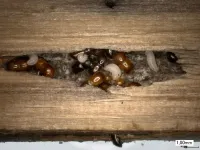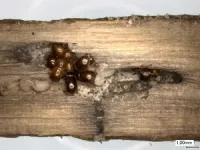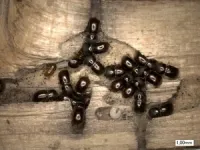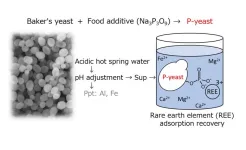(Press-News.org) The alnus ambrosia beetle Xylosandrus germanus, also known as the black stem borer, was accidentally introduced by humans from its native east Asia to North America and Europe around the beginning of the 20th century. X. germanus is a so-called ambrosia beetle, which means that it farms its own food: a specialized fungal symbiont which it ‘sows’ and tends inside the galleries that it digs inside wood. It is a destructive invasive pest, known to attack more than 200 species from 51 families of broadleaf and conifer trees. While it prefers to colonize dead wood, it can also infest and ultimately kill weakened or stressed trees.
A proven way to monitor or even control insect pests is by hijacking their communication system and manipulating it to trap them to their doom. Females of the alnus ambrosia beetle are known to aggregate on individual trees, suggesting that they use chemical signals to find each other and identify suitable trees. And now, scientists have cracked this chemical code. The results are published in Frontiers in Microbiology.
“Here we show that the alnus ambrosia beetle doesn’t produce its own pheromones during tree-host colonization, but rather uses the volatile compounds of their own fungal symbionts to aggregate en masse and potentially kill trees,” said the study’s senior author Dr Peter Biedermann, a professor at the Forestry Institute of the University of Freiburg in Germany.
First evidence of aggregation pheromones in ambrosia beetles
First author Antonio Gugliuzzo, a PhD student at the Department of Agriculture, Food and Environment of the University of Catania in Italy, added: “This is the first evidence for the existence of aggregation pheromones in ambrosia beetles of the tribe Xyleborini.”
Like all ambrosia beetles, X. germanus females carry their fungal symbionts in special pockets inside their head. The authors here used molecular methods to culture and identify the two most common symbionts as Ambrosiella grosmanniae, most likely the beetles’ primary food source, and an unknown species of Acremonium that the beetles may or may not eat. In 2020, the researchers caught mated dispersing X. germanus females near Freiburg, and allowed these dig galleries in an artificial medium based on beech sawdust, grow these two fungi, and rear their offspring.
They then used these fungi as bait in two-choice experiments in an apparatus called a still-air olfactometer. Here, X. germanus females were placed in an arena with two dead ends to enter and hide in: for example, one containing an isolate of the two symbionts A. grosmanniae and Acremonium sp., and another with an isolate of an unrelated fungus expected to be unattractive to the beetles – here, an uncharacterized Cladosporium species. The beetles’ preference will depend on their relative attraction to microbial volatile organic compounds (MVOCs) released by the fungi.
In a variant of this experiment, previously healthy beech branches infected with different fungi were presented to the beetles as options for choice.
Beetles prefer odor of symbionts and colonized branches
The results showed that the beetles were most attracted to A. grosmanniae MVOCs and least to Cladosporium MVOCs, and more to branches already colonized by A. grosmanniae than to uncolonized branches. The authors conclude that X. germanus uses MVOCs released by its two symbiont strains as a ‘synomone’ – a chemical signal that benefits both the emitter like and the receiver.
“Occupied tree branches may signal the beetles suitable substrate for the food fungi they depend on. This suitability is probably a delicate balance: trees need specific requirements to allow the beetles to farm the fungus successfully,” said Biedermann.
“But this isn’t an absolute requirement: if a female can’t find any conspecifics, or detect any MVOCs, she could still independently colonize a new tree branch.”
Promising avenue for biological control
These results immediately suggest a new method for biological control.
“Now that we know that the fungi produce attractive volatiles, we may be able to develop new trapping lures for the beetles on the basis of these compounds,” said Biedermann.
“Moreover, the use of specific volatile compounds for trapping purposes could contribute to the development of innovative and selective trapping methods targeting specific ambrosia beetle species, thereby minimizing catches of non-target arthropods living in the same environment.”
END
Farmer’ beetle finds suitable host trees by tracing scent of its fungus crop
First known chemical cue for aggregation of ambrosia beetles that isn’t synthesized by the species itself
2023-04-14
ELSE PRESS RELEASES FROM THIS DATE:
Treasure hunt in hot springs?
2023-04-14
The demand for precious metals and rare earths is expected to continue increasing in the future. Due to limited production areas, recycling from precision equipment and recovering from seawater and hot spring water are needed to ensure a stable supply.
A research group led by Professor Masayuki Azuma and Associate Professor Yoshihiro Ojima of the Osaka Metropolitan University Graduate School of Engineering has successfully developed an adsorbent material that can selectively recover rare earth elements (REEs) using environmentally friendly and inexpensive baker’s yeast and trimetaphosphate, which is used as a food additive.
The research group conducted experiments using ...
Why did the mpox (monkeypox) epidemic wane? Belgian researchers propose theory
2023-04-14
**Note: the release below is from the European Congress of Clinical Microbiology & Infectious Diseases (ECCMID 2023, Copenhagen, 15-18 April). Please credit the conference if you use this story**
Did the recent mpox (formerly known as monkeypox) outbreak end because of “network immunity”? That’s the theory being put forward by Belgian researchers at this year’s European Congress of Clinical Microbiology & Infectious Diseases (ECCMID) in Copenhagen, Denmark (15-18 April).
2022 saw a global outbreak of mpox, a viral ...
The Lancet Public Health: Hearing aids may protect against a higher risk of dementia associated with hearing loss, study suggests
2023-04-14
Peer-reviewed / Observational study / People
The Lancet Public Health: Hearing aids may protect against a higher risk of dementia associated with hearing loss, study suggests
Study of 437,704 people suggests those experiencing hearing loss and not using hearing aids may have a higher risk of dementia than people without hearing loss. Those using hearing aids did not appear to be at an increased risk of dementia.
After adjusting for other factors, study analysis suggests a 1.7% risk of dementia in people with hearing loss who are not using hearing aids, compared to 1.2% among those without hearing loss ...
One of first studies to assess new bivalent Covid-19 booster vaccine shows it is highly effective in reducing deaths and hospitalizations
2023-04-14
*Note: this is a joint press release from the European Congress of Clinical Microbiology & Infectious Diseases (ECCMID) and The Lancet Infectious Diseases. Please credit both the congress and the journal in your stories*
Since September, 2022, bivalent mRNA vaccines – which contain elements from both the original wild type COVID strain and an updated component from the omicron strain – have replaced older style monovalent boosters in the USA, Israel, and other countries. These vaccines were designed to help improve vaccine-induced immunity against the omicron variant and subsequent subvariants.
A new study published in The Lancet Infectious Diseases and ...
A $1 million boost to UT’s venture culture
2023-04-14
Adding fuel to The University of Texas at Austin’s startup engine, alumnus William “Billy” Freed, BBA ’81, and his family have given $1 million to the Herb Kelleher Entrepreneurship Center in the McCombs School of Business.
The gift establishes the Freed Family Entrepreneurship Excellence Fund and endows the Freed Family Pitch Competition, previously called DisrupTexas. Freed’s wife Cheryl, BA ’82, JD ’84; sons Tyler, BS ’17, and Russell, BBA ’21; and daughter-in-law Leslie Lugrin Freed, BS ’17, ...
Data can now be processed at the speed of light!
2023-04-14
How can Marvel movie character Ant-Man produce such strong energy out of his small body? The secret lies in the “transistors” on his suit that amplify weak signals for processing. Transistors that amplify electrical signals in the conventional way lose heat energy and limit the speed of signal transfer, which degrades performance. What if it were possible to overcome such limitation and make a high-performance suit that is light and small but without loss of heat energy?
A POSTECH team of Professor Kyoung-Duck Park and Yeonjeong Koo from the Department of Physics and a team from ...
Disrupted rhythms of rest and wakefulness contribute to worse symptoms in schizophrenia patients
2023-04-14
PITTSBURGH, April 13, 2023 – In a paper published today in Molecular Psychiatry, a team of scientists from the University of Pittsburgh in collaboration with researchers in Italy described shared patterns of sleep disturbances and irregularities in daily rhythms of rest and activity across patients with schizophrenia spectrum disorder, or SSD.
By using wrist monitors that measured activity and rest as proxies of wakefulness and sleep, researchers found that individuals with SSD who resided in psychiatric hospitals and those who manage their condition in outpatient settings had erratic sleep patterns, dysregulated transitions between sleep ...
How AI and a mobile phone app could help you quit smoking
2023-04-14
A stop smoking mobile app that senses where and when you might be triggered to light up could help people quit – according to University of East Anglia research.
Quit Sense is the world’s first Artificial Intelligence (AI) stop smoking app which detects when people are entering a location they used to smoke in. It then provides support to help manage people’s specific smoking triggers in that location.
Funding for the Quit Sense app has come from the National Institute for Health and Care Research (NIHR) and the Medical Research Council.
A study published today shows how the new ...
Nurse sounds a warning on hearing loss for COVID-19 patients
2023-04-14
A University of South Australia nursing lecturer has used her own COVID-19 experience to inform research into a little-known side effect of the virus – sudden deafness.
Kim Gibson, a registered nurse with a clinical background in neonatal intensive care, has documented her experience with sudden sensorineural hearing loss (SSNHL) five weeks after testing positive to COVID-19. She was fully vaccinated.
Her findings and recommendations are published in the latest edition of the British Medical Journal Case Reports.
Gibson developed acute hearing loss in one ear, along with ...
Scientists from Singapore and Sweden achieve promising results towards restoring vision in blindness caused by cellular degeneration in the eye
2023-04-14
SINGAPORE, 14 April 2023 – A preclinical study using stem cells to produce progenitor photoreceptor cells—light-detecting cells found in the eye—and then transplanting these into experimental models of damaged retinas has resulted in significant vision recovery. This finding, by scientists at Duke-NUS Medical School, the Singapore Eye Research Institute and the Karolinska Institute in Sweden, marks a first step towards potentially restoring vision in eye diseases characterised by photoreceptor loss.
“Our laboratory has developed a novel method that enables the production of photoreceptor ...
LAST 30 PRESS RELEASES:
On-demand upgraded recycling of polyethylene and construction of sustainable multifunctional materials based on the "LEGO" strategy
New "Stomata in-sight" system allows scientists to watch plants breathe in real-time
Anorexia nervosa may result in long-term skeletal muscle impairment
Narrative-based performance reviews deemed fairest by employees
New insights reveal how advanced oxidation can tackle emerging water pollutants
New review shows how biomass can deliver low-carbon gaseous fuels at scale
Climate change is quietly rewriting the world’s nitrogen cycle, with high stakes for food and the environment
Study finds SGLT-2 inhibitors linked to lower risk of diabetic foot nerve damage
Microbes may hold the key to brain evolution
Study examines how the last two respiratory pandemics rapidly spread through cities
Gender stereotypes reflect the division of labor between women and men across nations
Orthopedics can play critical role in identifying intimate partner violence
Worms as particle sweepers
Second spider-parasitic mite described in Brazil
January 2026 issues of APA journals feature new research on autism, pediatric anxiety, psychedelic therapy, suicide prevention and more
Private equity acquired more than 500 autism centers over the past decade, new study shows
New cervical cancer screening guidelines from the US Department of Health and Human Services
Estimated burden of COVID-19 illnesses, medical visits, hospitalizations, and deaths in the US from October 2022 to September 2024
Smartphone use during school hours by US youth
Food insecurity and adverse social conditions tied to increased risk of long COVID in children
Earliest, hottest galaxy cluster gas on record could change our cosmological models
Greenland’s Prudhoe Dome ice cap was completely gone only 7,000 years ago, first GreenDrill study finds
Scientific validity of blue zones longevity research confirmed
Injectable breast ‘implant’ offers alternative to traditional surgeries
Neuroscientists devise formulas to measure multilingualism
New prostate cancer trial seeks to reduce toxicity without sacrificing efficacy
Geometry shapes life
A CRISPR screen reveals many previously unrecognized genes required for brain development and a new neurodevelopmental disorder
Hot flush treatment has anti-breast cancer activity, study finds
Securing AI systems against growing cybersecurity threats
[Press-News.org] Farmer’ beetle finds suitable host trees by tracing scent of its fungus cropFirst known chemical cue for aggregation of ambrosia beetles that isn’t synthesized by the species itself







